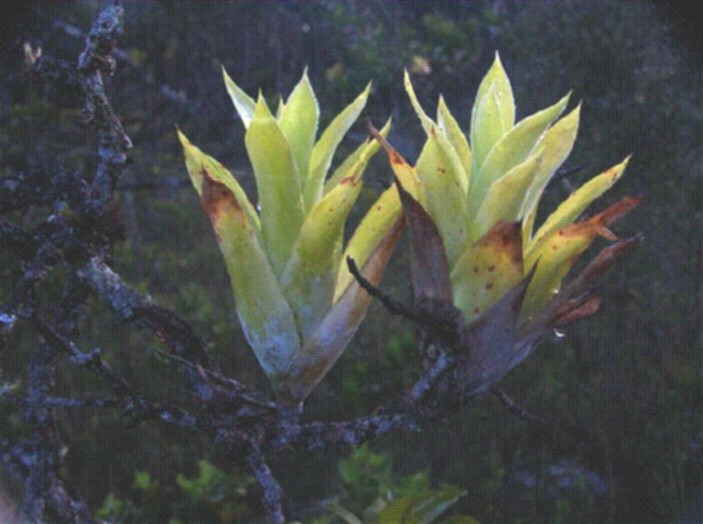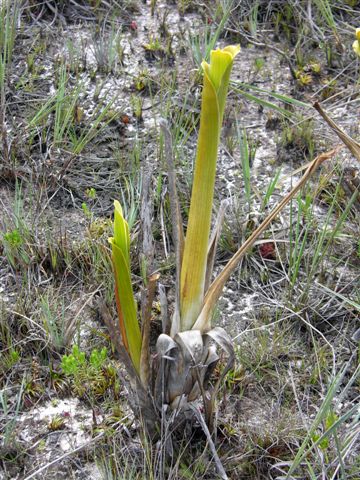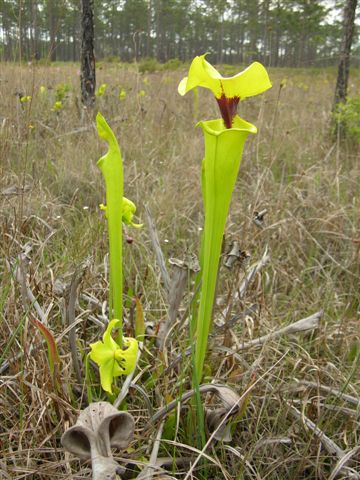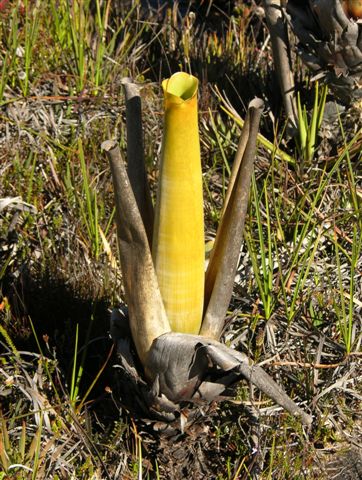
This article has been written for the BSA by Stewart McPherson. It is a Bromeliad specific extract of his recently published book of the same title.
Stewart has kindly been donated a first copy of the book to the BSA library.
See end of this article for publication details, and Stewart's worthy cause that profits are directed to.
Pitcher Plants of the Americas. by Stewart McPherson.
It was during Christopher Coumbus’s second voyage to the New World in 1493 that bromeliads were first collected and described by Europeans. During the five centuries since, at least 3,000 species have been described all of which occur exclusively in the Americas with the exception of only one species. When we examine this vast group of plants, we see a startling diversity in the differing shapes, sizes, structures and colours of bromeliads. This wide diversity and adaptability has enabled the Bromeliaceae to emerge as one of the most successful families of new world plants. Bromeliads have mastered terrestrial, epiphytic and even in some cases lithopytic habitats and within specific ecological niches, they can dominate local flora. Yet within this incredible group of plants, three particularly interesting species stand alone, for they have evolved the remarkable adaptations that enable the trapping of insects and other animal prey. They are the carnivorous bromeliads.
It may be surprising that just 0.1% of currently known bromeliad species are carnivorous. Carnivory in the plant kingdom is in all incidences, extremely rare, however tank bromeliads seem so naturally predisposed towards the trapping of prey that they would appear to be the most likely plants to evolve to become carnivorous – yet this is not so, they are far outnumbered by almost 600 species of non-bromeliad carnivorous plants. Three species of bromeliads belonging to two genera are currently seen to be carnivorous. Two belong to the genus Brocchinia (B. hechtioides and B. reducta) and one belongs to the genus Catopsis (C. berteroniana). In both cases, each genus consists of around 20 species, the overwhelming majority of which are non-carnivorous regular tank bromeliads. This in itself is unusual since all other genera of carnivorous plants consist exclusively of carnivorous species – perhaps this is an indication of a the recent evolution of carnivory among bromeliads. It is certainly clear that carnivory evolved separately in the two genera after Brocchinia and Catopsis diversified from an ancient common ancestor, thus carnivory has emerged at least twice in the Bromeliaceae although apparently, has been driven in parallel evolutionary directions.
All three species were first described during the late 19th and early 20th centuries as the botanical exploration of tropical parts of the New World intensified yet all three have remained obscure and little known until relatively recently. During the 1980s and 1990s, botanists discovered unusual morphological traits in C. berteroniana and B. reducta which displayed similarity to adaptations of known carnivorous plants. Experiments such as those conducted by Frank et al 1984 demonstrated that B. reducta, B. hechtioides and C. berteroniana caught prey much more readily than regular tank bromeliads and indeed in the case of C. berteroniana, 12 times more prey was caught in comparison to regular bromeliad species under identical conditions and circumstances.
It has always long been known that all tank bromeliads inherently trap insects which occasionally and randomly fall into the plants’ water reservoirs and drown but observations reveal that unlike regular tank bromeliads, B. hechtioides, B. reducta and C. berteroniana possess clear adaptations that actively elevate the rate by which insects are trapped. In essence these three bromeliads possess the ability to attract, retain, digest and absorb insect prey in fundamentally the same ways as other known carnivorous plants.

B. hechtioides, B. reducta and C. berteroniana produce foliage that collectively forms upright, hollow, water containing leaf rosettes that store a permanent quantity of rainwater which functions as the plants’ trap. The foliage in all three species is vividly coloured (bright yellow) and extremely conspicuous. The leaves of all three species are lined with a prominent coating of intensely UV-reflective white power. In the UV sensitive vision of insects, this powder coating must make the bromeliads stand out as brilliantly – perhaps to mimic conspicuous and often similarly shaped flowers. The presence of water and the occurrence of previously trapped dead insect within the leaves act as bait to entice new prey. Sweet secretions akin to nectar occurring within the leaf rosettes of the carnivorous bromeliads have also been noted by botanists and may also act as addition lures. The result is a brightly colourful and fragrant structure to which flying insects, beetles and ants in particular are drawn.

Perhaps mistaking the foliage for flowers, visiting insects explore the interior of the plants’ rosettes perhaps in search of nectars. The surface of the leaves of B. hechtioides, B. reducta and C. berteroniana is extremely waxy and very slippery. The UV-reflective white powder that coats the leaves is crumbly and loose and greatly hinders the ability of insects in securing a firm footing. The slightest movement of the plants in the wind or any falter on the part of the insect, causes it to flip and fall into the water filled leaf axils of the bromeliad. Trapped by the surface tension of the liquid contained within, the trapped prey is unable to climb up the slippery leaf exits, and eventually drowns. It is not clear the degree to which enzymes are secreted by B. hechtioides, B. reducta and C. berteroniana however the work of Plachno et al. 2005 demonstrated that at least simple enzymes such as Phosphatases are produced directly in the case of B. reducta. Bacteria and various micro organisms assist the digestion process and break down the soft remains of trapped prey releasing nutrients into the liquid contained within the bromeliads’ reservoirs. The resultant nutrient soup is absorbed directly by the bromeliads leaves.
The same basic structure is consistent in the traps of all three tank bromeliads. The foliage is arranged in a compact water tight rosette that is capable of retaining water either centrally or in the plants leaf axils. The foliage of C. berteroniana forms a relatively broad rosette which contains water predominantly in the plants’ leaf axils whereas the foliage of B. reducta is arranged in a tightly tubular rosette which offers little or no space for axil reservoirs but a large, central resovoir in the middle of the leaves. B. hechtioides is midway between the two extremes. It produces a loosely arrange leaf rosette with large leaf axil resovoirs but also a large central reservoir. The differences in the trap structures perhaps reflect differences in the ecology and habitats of the plants. C. berteroniana grows epiphytically and therefore requires small, compact, relatively streamlined foliage that is less likely to overturn and spill while the much more tubular, upright foliage of B. hechtioides and B. reducta are always anchored to the ground as these plants grow terrestrially.
The foliage of B. reducta appears to be the most specialized towards carnivory and indeed this species generally catches the largest amounts of prey of all three carnivorous bromeliads. It is reasonable to suggest that insects may escape more readily from the leaf axil reservoirs of B. hechtioides and C. berteroniana than the deep, tubular, tight rosettes of B. reducta. Yet to achieve this efficiency, B. reducta has evidently compromised the efficiency by which it can photosynthesize. Its tightly arranged foliage forms an effective trap but since the leaves are positioned upright and overlap one another, far less sunlight is caught than by the more widely spread foliage of B. hechtioides and C. berteroniana.
This trade off appears to afford B. reducta a number of very significant advantages, since it reduces dependence on the local availability of nutrients and enables the plant to flourishes in the most marginal areas of habitat were barren and inhospitable conditions reduce competition. In such areas a reduced rate of photosynthesis is unlikely to be a disadvantage. Consequently, on the desolate summits of the tablelands of Venezuela, B. reducta in particularly is especially prevalent and frequently represents the overwhelmingly dominant species of large plant.
The ability of the carnivorous Brocchinia to acquire nutrients through carnivory is apparently so significant that both B. hechtioides and B. reducta are able to grow rooted directly to bare rock – their modified leaves provide a permanent and stable supply of water and a constant source of essential nutrients in the form of trapped insects.

The mechanisms and processes by which B. hechtioides, B. reducta and C. berteroniana trap insects are essentially exactly the same as those employed by the genera of pitcher plants Cephalotus, Darlingtonia, Heliamphora, Nepenthes and Sarracenia. Insects are lured through various forms of bait, encouraged to fall into reservoirs of water that the plants’ leaves hold, and then are prevented from escaping and eventually digested so that nutrients can be absorbed by the plant. The only significant difference between the carnivorous bromeliads and the conventional pitcher plants lies in that the trap of the carnivorous bromeliads consists of several leaves rather than just one. On this basis, McPherson 2006 handles the carnivorous Brocchinia and Catopsis as ‘bromeliad pitcher plants’ and refers to the five conventional genera as ‘true pitcher plants’.
The fundamental morphological similarities between the bromeliad pitcher plants and members of the true pitcher plants are often extraordinary. The clearest example is the similarities of the structure of the trap of B. reducta and S. flava. Both plants produce traps that are narrow, tubular, and approximately of similar heights. In both, the ratio of width to height is the roughly the same, probably reflecting the most efficient balance for the retaining of prey. Both are highly UV-reflective and both are bright yellow and contrast conspicuously with surrounding vegetation. Both plants are lined with vertical veins and the uppermost parts in both are often infundibular. If the sweet bait of B. reducta is confirmed, then both will essentially possess exactly the same lures to attract prey. Although the two plants have evolved completely separately, they appear to have evolved in direct parallel with one another.


Arguably the simplicity of the traps of B. reducta offer significant advantages over the Sarraceniaceae including the Heliamphora – a genus of pitcher plants that are closely related to Sarracenia. Whereas the traps of S. flava last only a few months and die back every winter, the collective trap of B. reducta is maintained through the combined effort of several individual leaves and is therefore more durable and lasts the entire length of an individual plant. Since Brocchinia occur in tropical areas, the lack of cold winter temperatures allows continual growth year round so that the plants ‘pitcher’ is permanently maintained as older leaves die back. Prey that is trapped by B. reducta may therefore be digested over a longer period and perhaps nutrient extraction per prey is more efficient. On the other hand, the Sarraceniaceae consist of several leaf traps and the combined total of prey which each plant catches may therefore be greater than that of B. reducta. These variations of the pitcher plant theme arise from differences in climatic and environmental conditions as well as evolutionary and ecological history, yet the fact that evolution can yield such essentially comparable results is extremely interesting.
At the start of the 21st century, large blanks remain in our understanding of even the basic ecology and taxonomy of the carnivorous bromeliads. Fundamental details of the floral structure and reproductive traits of these plants, especially the Brocchinia remain unclear and indeed even the boundaries between each of the species of Brocchinia remains very unclear. There are at least two other taxa of Brocchinia which do not fit into any currently described Brocchinia sp. yet at the same time, these undescribed variants show very clear affinity to B. hechtioides and B. reducta.
One is a much larger version of B. hechtioides which consists of three times as many leaves, each of which are up to 100 cm tall. It differs from all currently known Brocchinia sp. in that its rosette is upright, compact and forms an essentially tubular vessel similar to B. reducta and B. hectioides yet it is considerably larger than both.
A second variant is more similar to B. reducta and possesses a tightly tubular rosette that is much shorter, but considerably stouter so that the result is almost triangular in cross section. Both undescribed variants appear to display all of the characteristics towards carnivory that B. hechtioides and B. reducta display – perhaps there are more than two species of carnivorous Brocchinia after all.

It will certainly be many years until we fully understand these remarkable plants and their extraordinary abilities to trap insects and other small animals.
Stewart McPherson’s new books Pitcher Plants of the Americas and Lost Worlds examine the wild ecology and remarkable diversity of B. hechtioides, B. reducta and C. berteroniana. Stewart is selling copies personally through his online company www.redfernnaturalhistory.com to raise money for the Meadowview Biological Station to actively support the permanent protection of pitcher plants and their habitats – please visit www.redfernnaturalhistory.com/conservation.htm.
Bibliography
Frank, J.H., O'Meara, G.F. 1984. “The bromeliad Catopsis berteroniana traps terrestrial arthropods but harbors Wyeomyia larvae (Diptera: Culicidae)” Florida Entomologist 67: 418-424.
McPherson, S. 2006. Pitcher Plants of the Americas. Blacksburg, Virginia: McDonald and Woodward
McPherson, S. 2007. Lost Worlds. Blacksburg, Virginia: McDonald and Woodward
Plachno, B. J.; Jankun, A.: Phosphatase 2005. “Activity in Glandular Structures of Carnivorous Plant Traps” International Botanical Congress 2005.